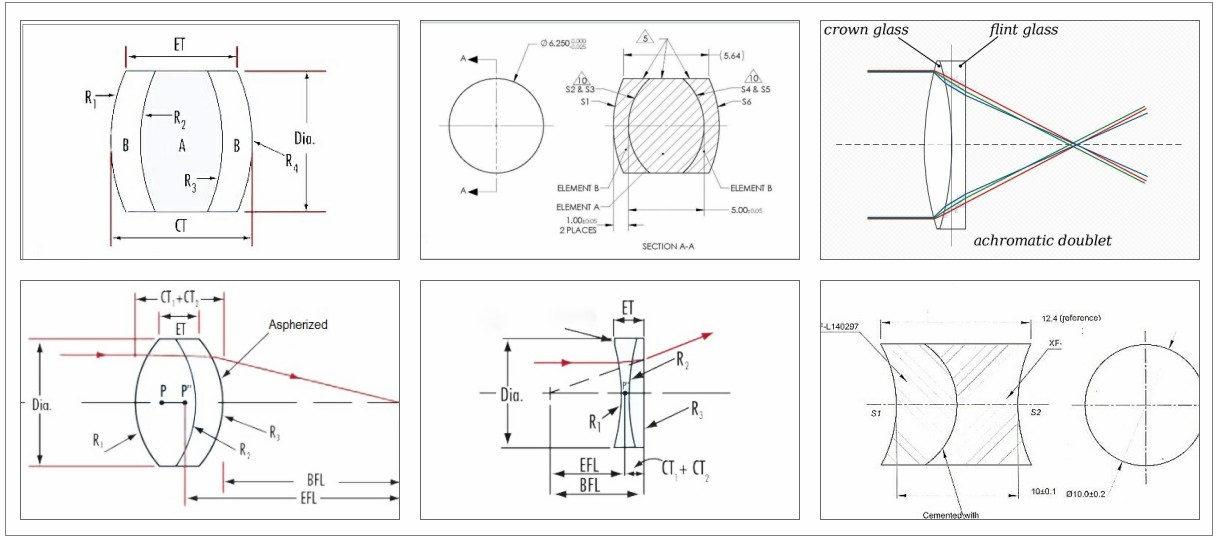product origin:
Chinashipping port:
Fuzhou Chinalead time:
4 working weekspayment:
T/T Payment, Western Union1. What do you mean by achromatic combination?
An achromatic lens can be defined as a lens which is made by acombination of two different types of lenses carrying different focal powers in a manner such that the images formed by the light of both the combined lenses are free from chromatic aberration or achromatism.
2. What are achromatic lenses used for?
Achromatic Lenses are used to minimize or eliminate chromatic aberration. The achromatic design also helps minimize spherical aberrations. Achromatic Lenses are ideal for a range of applications, including fluorescence microscopy, image relay, inspection, or spectroscopy.
Achromatic Lenses
Cemented Achromatic Doublets
Cemented Achromatic Triplets
Achromatic Doublet Pairs
Negative Achromatic Lenses
Achromatic Cylindrical Lenses
Near UV Achromatic Lenses
Near-IR (NIR) Achromatic Lenses
UV-to-NIR Corrected Triplets

Specification
|
Material: |
Crown Glass&Flint Glass CDGM, Schott, Ohara etc |
|
Dimension Tolerance: |
±0.1mm(Standard), ±0.01mm(High Precision) |
|
Center Thickness Tolerance: |
±0.1mm(Standard), ±0.05mm(High Precision) |
|
Paraxial Focal Length: |
±2% |
|
Surface quality: |
60/40(Standard), 20/10(High Precision) |
|
Clear Aperture: |
>85% |
|
Surface Figure: |
λ/2(Standard), λ/4(High Precision) @633nm |
|
Centration: |
3 arc minutes |
|
Bevel: |
<0.25mm×45° |
|
Coating: |
Upon requirement |
| Part No. | F(mm) |
Φ (mm) |
Nd A | Nd B |
R1 (mm) |
R2=R3 (mm) |
R4 (mm) |
Tc1 (mm) |
Tc2 (mm) |
Fb (mm) |
|---|---|---|---|---|---|---|---|---|---|---|
| ULAC020006 | 20 | 6 | BK7 | SF5 | 12.36 | -8.51 | -24.38 | 2.6 | 1.0 | 18.29 |
| ULAC025006 | 25 | 6 | BK7 | SF5 | 15.7 | -10.66 | -29.99 | 2.3 | 1.0 | 23.45 |
| ULAC030006 | 30 | 6 | BK7 | SF5 | 18.88 | -12.94 | -34.68 | 1.9 | 1.0 | 28.69 |
| ULAC025008 | 25 | 8 | BK7 | SF5 | 15.6 | -10.81 | -30.48 | 2.9 | 1.0 | 23.12 |
| ULAC030008 | 30 | 8 | BK7 | SF5 | 18.88 | -12.88 | -36.22 | 2.7 | 1.0 | 28.27 |
| ULAC025127 | 25 | 12.7 | BK7 | SF5 | 15.6 | -11.40 | -31.05 | 4.3 | 1.3 | 22.25 |
| ULAC030127 | 30 | 12.7 | BK7 | SF5 | 18.53 | -13.49 | -37.84 | 4.0 | 1.3 | 27.36 |
| ULAC040127 | 40 | 12.7 | BK7 | SF5 | 25.23 | -17.54 | -48.75 | 3.4 | 1.3 | 37.77 |
| ULAC050127 | 50 | 12.7 | BK7 | SF5 | 31.26 | -21.93 | -62.37 | 3.1 | 1.3 | 47.99 |
| ULAC075127 | 75 | 12.7 | BK7 | SF5 | 46.77 | -32.96 | -94.62 | 2.6 | 1.3 | 73.23 |
| ULAC040018 | 40 | 18 | BK7 | SF5 | 24.27 | -18.35 | -53.09 | 5.4 | 1.5 | 36.51 |
| ULAC050018 | 50 | 18 | BK7 | SF5 | 31.69 | -22.00 | -60.57 | 4.8 | 1.5 | 46.98 |
| ULAC060018 | 60 | 18 | BK7 | SF5 | 37.84 | -26.49 | -73.79 | 4.1 | 1.5 | 57.3 |
| ULAC080018 | 80 | 18 | BK7 | SF5 | 49.55 | -36.81 | -165.58 | 3.4 | 1.5 | 77.41 |
| ULAC060254 | 60 | 25.4 | BK7 | SK5 | 37.33 | -27.16 | -75.86 | 7.0 | 2.0 | 55.56 |
| ULAC120254 | 120 | 25.4 | BK7 | SF5 | 73.28 | -54.33 | -159.96 | 4.2 | 2.0 | 117.1 |
| ULAC025127N | -25 | 12.7 | BK7 | F2 | -15.6 | 13.09 | 44.16 | 3.0 | 2.7 | 27.5 |
| ULAC050254N | -50 | 25.4 | BK7 | F2 | -31.19 | 24.89 | 85.31 | 3.0 | 4.2 | 53.3 |
Hot Tags :